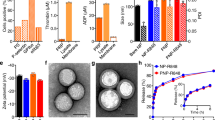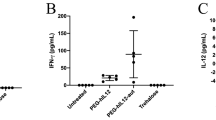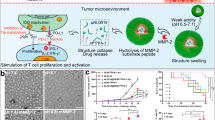Abstract
We have developed surface-shielded ligand-polycation based gene delivery systems which are able to target gene expression to distant tumors after systemic application. Tumor-specific targeting is achieved by (1) incorporation of cell-binding ligands; and (2) shielding of the complexes from non-specific interactions with blood components and non-target cells. Shielding of polycation/DNA complexes can be achieved by coating with either polyethylene glycol or by incorporating the ligand transferrin at high densities. Following systemic application, surface-shielded DNA complexes coding for a highly active, yet highly toxic cytokine, tumor necrosis factor-α (TNFα), localized gene expression to distant tumors, resulting in hemorrhagic tumor necrosis and inhibition of tumor growth. TNFα activity was confined to the tumor without systemic TNF-related toxicity. These results indicate that targeted gene delivery may be an attractive strategy to use highly potent molecules in cancer treatment.
This is a preview of subscription content, access via your institution
Access options
Subscribe to this journal
Receive 12 print issues and online access
$259.00 per year
only $21.58 per issue
Buy this article
- Purchase on Springer Link
- Instant access to full article PDF
Prices may be subject to local taxes which are calculated during checkout



Similar content being viewed by others
References
Wagner E, Curiel D, Cotten M . Delivery of drugs, proteins and genes into cells using transferrin as a ligand for receptor-mediated endocytosis Adv Drug Del Rev 1994 14: 113–136
Kircheis R et al. Coupling of cell-binding ligands to polyethylenimine for targeted gene delivery Gene Therapy 1997 4: 409–418
Erbacher P, Remy JS, Behr JP . Gene transfer with synthetic virus-like particles via the integrin-mediated endocytosis pathway Gene Therapy 1999 6: 138–145
Blessing T et al. Different strategies for formation of PEGylated EGF-conjugated PEI/DNA complexes for targeted gene delivery Bioconj Chem 2001 12: 529–537
Brunner S et al. Cell cycle dependence of gene transfer by lipoplex, polyplex and recombinant adenovirus Gene Therapy 2000 7: 401–407
Dachs GU et al. Targeting gene expression to hypoxic tumor cells Nature Med 1997 3: 515–520
Kircheis R et al. Polycation-based DNA complexes for tumor-targeted gene delivery in vivo J Gene Med 1999 1: 111–120
Kircheis R et al. Polyethylenimine/DNA complexes shielded by transferrin target gene expression to tumors after systemic application Gene Therapy 2001 8: 28–40
Boussif O et al. A versatile vector for gene and oligonucleotide transfer into cells in culture and in vivo - polyethylenimine Proc Natl Acad Sci USA 1995 92: 7297–7301
Goula D et al. Polyethylenimine-based intravenous delivery of transgenes to mouse lung Gene Therapy 1998 5: 1291–1295
Kichler A, Leborgne C, Coeytaux E, Danos O . Polyethylenimine-mediated gene delivery: a mechanistic study J Gene Med 2001 3: 135–144
Ogris M et al. PEGylated DNA/transferrin-PEI complexes: reduced interaction with blood components, extended circulation in blood and potential for systemic gene delivery Gene Therapy 1999 6: 595–605
Plank C, Mechtler K, Szoka F, Wagner E . Activation of the complement system by synthetic DNA complexes: a potential barrier for intravenous gene delivery Hum Gene Ther 1996 7: 1437–1446
Kircheis R, Wagner E . Polycation/DNA complexes for in vivo gene delivery Gene Ther Regul 2000 1: 95–114
Wightman L et al. Different behavior of branched and linear polyethylenimine for gene delivery in vitro and in vivo J Gene Med 2001 3: 362–372
Gerlowski LE, Jain RK . Microvascular permeability of normal and neoplastic tissues Microvasc Res 1986 31: 288–305
Hobbs SK et al. Regulation of transport pathways in tumor vessels: role of tumor type and microenvironment Proc Natl Acad Sci USA 1998 95: 4607–4612
Old LJ . Tumor necrosis factor (TNF) Science 1985 230: 630–632
Beutler B, Milsark IW, Cerami A . Passive immunization against cachectin/tumor necrosis factor protects mice from lethal effect of endotoxin Science 1985 229: 869–871
Eggermont AM et al. Isolated limb perfusion with tumor necrosis factor and melphalan for limb salvage in 186 patients with locally advanced soft tissue extremity sarcomas. The cumulative multicenter European experience Ann Surg 1996 224: 756–764
Author information
Authors and Affiliations
Rights and permissions
About this article
Cite this article
Kircheis, R., Wightman, L., Kursa, M. et al. Tumor-targeted gene delivery: an attractive strategy to use highly active effector molecules in cancer treatment. Gene Ther 9, 731–735 (2002). https://doi.org/10.1038/sj.gt.3301748
Published:
Issue Date:
DOI: https://doi.org/10.1038/sj.gt.3301748
Keywords
This article is cited by
-
In vitro anticancer activity of pyrano[3, 2-c]chromene derivatives with both cell cycle arrest and apoptosis induction
Medicinal Chemistry Research (2020)
-
Novel anti-cancer agents: design, synthesis, biological activity, molecular docking, and MD simulations of 2, 3, 4, 5-tetrahydro-1H-pyrido-[4,3-b]indole derivatives
Medicinal Chemistry Research (2019)
-
Trastuzumab-targeted gene delivery to Her2-overexpressing breast cancer cells
Cancer Gene Therapy (2016)
-
Development of functional polyplex micelles for systemic gene therapy
Polymer Journal (2014)
-
Molecular scintigraphic imaging using 99mTc–transferrin is useful for early detection of synovial inflammation of collagen-induced arthritis mouse
Rheumatology International (2008)



